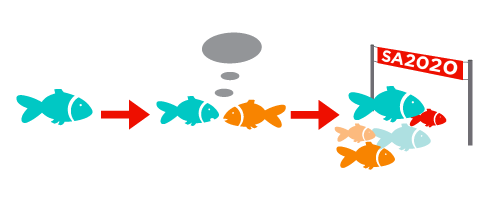 By Jeanne Russell, SA2020 Chief Strategist
By Jeanne Russell, SA2020 Chief Strategist
“To the Chief of Strategery:
I appreciate your fancy titles over there at 2020, and I want to be helpful. So please give me a clue as to what “Collective-Impact-Director” means.”
So began an email from a friend. And while he was less than serious, he is not the only SA2020 supporter to ask me: what in the heck is collective impact, anyhow?
And how is it different from good-old fashioned, plain vanilla collaboration?
And furthermore, what about those folks who were doing collective impact before it was cool (shout out, United Way of San Antonio and Bexar County), but just didn’t call it that?
Collective impact in many ways is just collaboration done well. Nothing new. But what is new is that big-time folks (like FSG, Strive Together and Living Cities) have started identifying the core components of what makes an effective multi-sector collaboration, and they are most interested in supporting those collaborations that can really demonstrate results. (Read more here.)
Now that sounds attractive for San Antonio, doesn’t it?
In 2013, SA2020 adopted Collective Impact as our organizing framework. And we’re not the only ones! San Antonio is a city that is already using collective impact as a way to strengthen collaborations and make sure they achieve results. One of our original lead partners, the P16Plus Council of Greater Bexar County, preceded us in adopting Collective Impact to guide their work as a cradle to career planning collaboration for Bexar County.More recently, they were recognized by the national organization Strive Together for their groundbreaking work.

Remember that one scene from Finding Nemo? Through collective impact, SA2020 tries to get everyone swimming in the same direction!
A number of coalitions working on key SA2020 indicators also follow a Collective Impact model. Examples include the Mayor’s Fitness Council, which is tackling obesity, the Diplomás coalition for Latino Student Success, which is focused on improving Latino college graduation rates.
The Eastside Promise Neighborhood, along with Wheatley Choice Neighborhood and the Promise Zone in the same EastPoint area exemplify place-based collective impact, bringing together the school district, the city, the housing authority and key nonprofits such as the United Way to focus on improving health, educational, housing and economic outcomes for the people who live in some of our poorest census tracts.
The San Antonio Teen Pregnancy Prevention Collaborative is one of the most successful so far—we’ve already met our community target for reducing the teen birth rate, and have set a higher target for 2020. A key to this group’s success was a willingness to set aside differences over tactics, as long as all the organizations agreed to focus on a single outcome of reducing births to teenagers.
The biggest reason we adopted this model was because we noticed a similar structure to the work in the areas where we could really see the needle moving—such as teen pregnancy. These collaboratives had (1) clear goals, (2) strategies they sought to measure, (3) support from an effective organization (such as Metro Health), and (4) continuous, proactive communication – all pillars of successful collective impact work.
That third piece was particularly significant to us. As a nonprofit, one of SA2020’s major roles is to act as a “backbone” organization, supporting the many collective impact efforts focused on SA2020 goals. In this model, a backbone agency does more than just bring people together at one table to chat—they provide support to those people, guiding strategy and helping to hold everyone accountable to the goals.

Living Cities representatives visited San Antonio last friday, May 9th, and had a bit of fun touring the new Geekdom, visiting a school on the Eastside, and getting caught in the rain at Hemisfair Park.
To support and strengthen SA2020’s role as a backbone to these networks, we are excited to announce that SA2020 has received a planning grant from Living Cities, a collaborative of the nation’s largest foundations and financial institutions. San Antonio was one of five cities to receive this grant as part of an expansion of their signature effort, The Integration Initiative (TII), which supports civic leaders in cities coming together in new ways to increase opportunities for low-income people at scale. We were also lucky enough to welcome representatives from Living Cities last Friday, May 9th, visiting San Antonio to learn more about the exciting work happening here and opportunities for collaboration throughout the upcoming one-year planning process.
This grant from Living Cities will allow us to strengthen our work as a backbone organization, particularly with a focus on reducing poverty in San Antonio. We’ll be focused initially on the Eastside’s place-based efforts to transform that community, working with our partners to explore remaining gaps that could be addressed as well as lessons learned that could be scaled beyond the geography of those neighborhoods.
We’re pretty excited about this collective impact thing, in case it isn’t 100 percent clear. So much so, that we also just created a new job for a Collective Impact Director (here’s where I answer that question from the beginning.) This person’s job will be to help support the many collective impact groups that already exist, and the ones that we know will soon start. He or she will help with the hard parts of collective impact, which involve having honest conversations about data and what’s working, and then shifting resources toward that stuff and/or making policy recommendations to strengthen that work. Collective Impact isn’t easy, but it’s a hugely important strategy to help us successfully achieve our goals for San Antonio. We know that collaboration isn’t all kumbaya and apple pie, but in today’s multi-complicated world, it’s pretty much collaborate – or die.
Yours in collaboration,
Jeanne Russell
Chief of Strategery, SA2020

